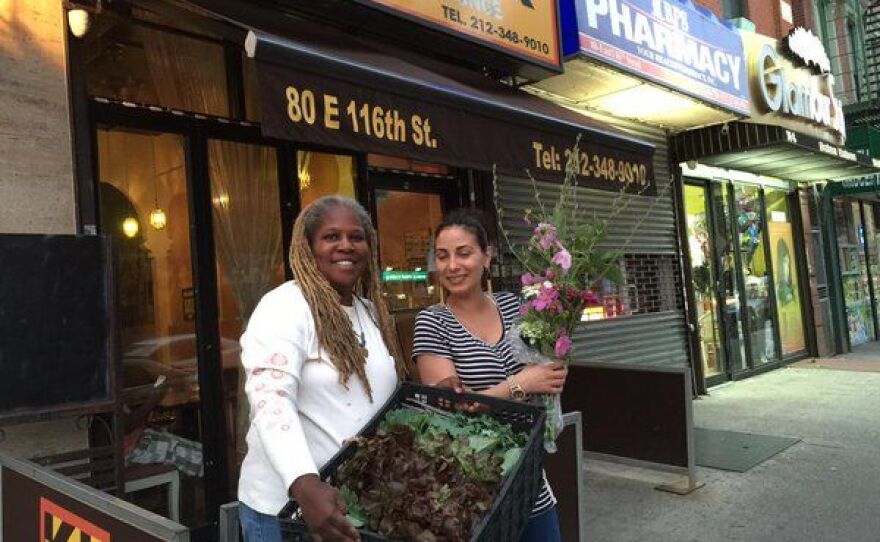In 2014 Harrisonburg was designated Virginia’s first culinary district. More than 30 food-themed businesses in the downtown area make it a mecca for locally-sourced food and beverage in the Shenandoah Valley. WMRA’s Amy Loeffler reports how what’s good for your belly can also mean a more sustainable community food system.
I'm sitting at the bar in Harrisonburg’s Pure Eats. It’s a chilly fall afternoon and patrons around me are indulging in the restaurant’s comfort fare. Juicy burgers made from locally sourced beef, regional craft beers, and the restaurant’s signature cake donuts are all popular menu items. Like many establishments in Harrisonburg, it’s a must-nosh stop for gastronomes who value supporting local food producers. One producer, Rosalea Potter and her family, supply the beef that Pure Eats uses to make its hamburgers.
ROSALEA POTTER: We're grass fed ‘til 8, 900 pounds and then we finish our cattle out on a diet of corn, corn silage, and brewers grain, and the brewers grain we get from Devil's Backbone Outpost Brewery which is here in Lexington. And the reason that we chose that program is because we want a consistent product all year long. And so if you kinda look at these carcasses down through here, they kinda all look the same, and that's our goal. You can come by in one time and buy a steak and when you come back two weeks later, it's gonna taste the same.
Beyond satisfying a dining public that is hungry to support local farmers and indulge in the bounty of regionally sourced meat, produce, and dairy products in the area, supporting local foodsheds is vital to the health of communities across the commonwealth.
A food desert study conducted by Virginia Tech and Virginia State University found that 17.8 percent of Virginia’s population lives in places where access to healthy food is limited, and despite being an area of high agricultural output, in Harrisonburg the food insecurity rate was as high 18.4 percent. A figure that is well above the national average of 7.3 percent.
STEVE COOK: Local food is super important to the local economy it keeps the dollars right here circulating around in Rockingham and Harrisonburg.
That’s Steve Cooke. He’s the general manager of Friendly City Food Co-op.
COOKE: Our purpose here is to keep as many of our dollars from local food production here in the Shenandoah Valley circulating around.
And just how many dollars does local food have the potential to generate? According to the same food desert study commissioned by the state, if each household in Rockingham County and Harrisonburg spent just $10 a week on local foods the cumulative effect would generate $23.2 million a year.
COOKE: My employees get paid from the money that we make selling local foods and they go and spend their money at the farmer’s market or on the things that we sell here, so it all just keeps those loops churning. The general distance that conventional food travels from farm-to-table is about 1,500 miles, for organic foods it's actually twice that because we are on the other side of the country from California, Central Valley, where most of the organic food production is happening. So you could eat really healthy and buy organic food, but the cost to the environment is that that food travels in a truck or a train all the way across the country. If you buy local organic or buy local food the food miles are much less. It’s fresher, it's more nutritious, it tastes better and all of those things come into play, plus you're supporting the home team you're supporting the local economy.
At a recent farm-to-table conference in Weyers Cave, producers gathered to see local food systems in action. One of the participants, Karen Washington of Rise and Root Farm, has been a significant player in connecting urban farming in New York City to social justice.
KAREN WASHINGTON: How do we get the next generation to not only be farmers, but be profitable farmers. The days of volunteerism, the days of just making it is not gonna cut it, and so what young people do bring in that resource of innovation, of biotechnology, all the things that are necessary to sort of move to the next generation of agriculture but we must be intentional to the fact that it has to be diverse, and it has to be inclusive so that across the board all people no matter their ethnicity or their gender have the opportunity to grow food.
While changing food policy and attitudes toward food production may be a long row to hoe, consumers have the most immediate power right now to make a difference in their own communities by creating policy change with their wallets. Back at Pure Eats, customers are experiencing the most direct way local food systems benefit from incorporating food true to its roots: with their stomachs.




